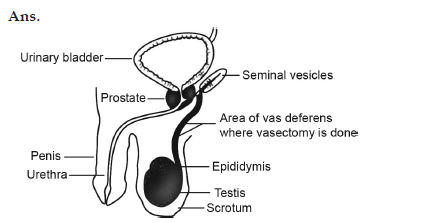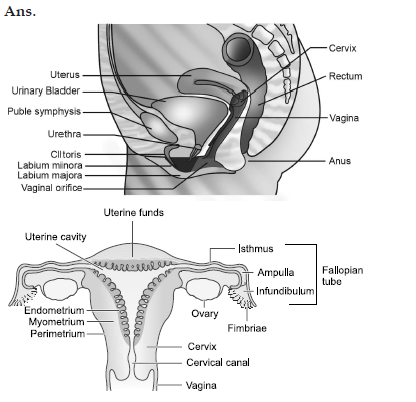NCERT Solutions for Class 12 Biology Chapter 3: Human Reproduction
NCERT Solutions for Class 12 Biology Chapter 3 Free PDF Download
Please Click on Free PDF Download link to Download the NCERT Solutions for Class 12 Biology Chapter 3 Human Reproduction
To download the complete Syllabus (PDF File), Please fill & submit the form below.
1. Fill in the blanks:
(a) Humans reproduce ________ (asexually/sexually).
(b) Humans are ___________ (oviparous, viviparous, ovoviviparous).
(c) Fertilisation is _______ in humans (external/internal).
(d) Male and female gametes are ________(diploid/haploid).
(e) Zygote is __________ (diploid/haploid).
(f) The process of release of ovum from a mature follicle is called _________.
(g) Ovulation is induced by a hormone called __________.
(h) The fusion of male and female gametes is called _________.
(i) Fertilisation takes place in _________.
(j) Zygote divides to form _________ which is implanted in uterus.
(k) The structure which provides vascular connection between foetus and uterus is called _________ .
Ans. (a) sexually
(b) viviparous
(c) internal
(d) haploid
(e) diploid
(f) ovulation
(g) LH (Luteinizing hormone)
(h) fertilization
(i) ampullary-isthmic junction (fallopian tube)
(j) blastocyst
(k) placenta (Umbilical cord)
2. Draw a labelled diagram of male reproductive system.

3. Draw a labelled diagram of female reproductive system.

4. Write two major functions each of testis and ovary.
Ans. Functions of testes:
(i) Formation of sperm by the process of spermatogenesis.
(ii) Secretion of testosterone hormone.
Functions of ovary:
(i) Formation of ova by the process of oogenesis.
(ii) Secretion of female hormones like estrogens, progestron and relaxin.
5. Describe the structure of a seminiferous tubule.
Ans. Seminiferous tubules are highly coiled tuves, which are lined on the inside by:
(i) The cuboidal cells are called male germ cells that undergoes meiotic division to form sperm calls.
(ii) Few large pyramidal cells called sertoli cell or nurse cells that provide nutrition and molecular to the germ cells.
6. What is spermatogenesis? Briefly describe the process of spermatogenesis.
Ans. Spermatogenesis: It is a process of producing sperms from immature germ cell in male.
Steps/Process of Spermatogenesis:
(i) A diploid spermatogonium (male germ cell) increases in size to form a diploid primary spermatocyte.
(ii) Diploid primary spermatocyte undergoes first meiotic division, which is a reductional division to form two equal haploid secondary spermatocyte.
(iii) Each secondary spermatocyte than undergoes second meiotic division (meiosis 11) to form two equal haploid spermatids. Hence, totol 4 Hapoloid spermatids produced.
(iv) These spermatids are transformed into spermatozoa (sperm) by the process of spermiogenesis.

7. Name the hormones involved in regulation of spermatogenesis.
Ans. The hormones involved in regulation of spermatogenesis are GnRH, LH, FSH and androgens.
FSH acts on sertoli cells, whereas LH acts on lydig cells of the testes and stimulates the process of spermatogenesis.
8. Define spermiogenesis and spermiation.
Ans. Spermiogenesis is the process of transformation of spermatids into mature flagellated spermatozoa (sperms). Whereas spermiation is the process of release of mature spermatozoa. In this spermatozoa are shed into the lumen of seminiferous tubule for transport.
9. Draw a labelled diagram of sperm.

10. What are the major functions of male accessory ducts and glands?
Ans. Major functions of male accessory ducts (rete testes, vasa efferentia, epididymis and vas deferens) is storage and transport of sperm from testes to outside through urethra.
Major functions of male accessory gland (seminal vesicles, prostate gland, Bulbourethral glands) are to make constitute seminal plasma which is rich in fructose (secreted by seminal vesicle), calicum (secreted by prostate gland) at certain enzymes. The secretions of bulbourethral glands also help in the lubrication of the penis.
11. What are the major components of seminal plasma?
Ans. Major functions of male accessory ducts (rete testes, vasa efferentia, epididymis and vas deferens) is storage and transport of sperm from testes to outside through urethra.
Major functions of male accessory gland (seminal vesicles, prostate gland, Bulbourethral glands) are to make constitute seminal plasma which is rich in fructose (secreted by seminal vesicle), calicum (secreted by prostate gland) at certain enzymes. The secretions of bulbourethral glands also help in the lubrication of the penis.
12. What is oogenesis? Give a brief account of oogenesis.
Ans. The process of formation of a mature female gamete (ovum) is called oogenesis. It occurs in the ovaries of female reproductive system. Oogenesis is a discontinuous process it begins before birth, stops in midprocess and only resumes after menarch.
It occurs in three phases: Multiplicative phase (formation of oogonia mitotically from the primary germ cells), Growth phase (growth of oogonia into primary oocyte) and Maturation phase (formation of mature ova from primary oocyte through meiosis).
Maturation phase produces two haploid cells: Larger one called secondary oocyte and the smaller one called polar bodies (1st polar body). Meiosis II of secondary oocyte results in the formation of functional egg or ovum and a second polar body: The first polar body may also divide to form two polar bodies of equal sizes which do not take part in reproduction and ultimately degenerates. First maturation division may be completed in the ovaries just prior to ovulation but second one (Final) is completed outside the ovary after fertilization. Secondary oocyte is female gamete in which the 1st meiotic division is completed and second meiotic division (Metaphase stage) has begin. The egg is released at secondary oocyte stage under the effect of LH.

13. Draw a labelled diagram of a section through ovary.

14. Draw a labelled diagram of a Graafian follicle.

15. Name the functions of the following:
(a) Corpus luteum
(b) Endometrium
(c) Acrosome
(d) Sperm tail
(e) Fimbriae
Ans. (a) Corpus luteum: The corpus luteum secretes large amounts of progesterone which is essential for maintenance of the endometrium of the uterus.
(b) Endometrium: It causes cyclic changes during mestrual cycle and prepare for implantaion.
(c) Acrosome: It has hydrolytic eneyme required to penetrate the ovum.
(d) Sperm tail: Tail facilitates sperm motility which is essential for fertilization.
(e) Fimbriae: Fimbriae help in collection of the ovum after ovulation.
16. Identify True/False statements. Correct each false statement to make it true.
(a) Androgens are produced by Sertoli cells. (True/False)
(b) Spermatozoa get nutrition from sertoli cells. (True/False)
(c) Leydig cells are found in ovary . (True/ False)
(d) Leydig cells synthesize androgens. (True/ False)
(e) Oogenesis takes place in corpus luteum. (True/False)
(i) Menstrual cycle ceases during pregnancy . (True/False)
(g) Presence or absence of hymen is not a reliable indicator of virginity or sexual – experience. (True/False)
Ans. (a) False, Androgens or male sex hormones (e.g, testosterone) are secreted by Leydig cells.
(b) True.
(c) False, Leydig cells are found in testis.
(d) True.
(e) False, Oogenesis takes place in ovary. (f) True.
(g) True.
17. What is menstrual cycle? Which hormones regulate menstrual cycle?
Ans. Menstrual cycle is a series of cyclic changes found in the reproduction tract of human female during her reproductive life, at an interval of 28 days. It is characterised of menstruation in the first days.
The hormones that regulats minstrual cycles are:
(i) FSH (Follide stomulating hormone)
(ii) LH (Luteinizing Hormone)
(iii) Estrogens
(iv) Progostrons.
18. What is parturition ? Which hormones are involved in induction of parturition?
Ans. Parturition: It is a process of giving birth to a body as the development of the faetus completed in the mother’s womb.
Hormones involved in parturization: The hormones involved mother’s womb.
(i) Oxytocin: It leads to the contraction of smooth muscles of myotrium of the uterus, which directs the foetus towards the birth canal.
(ii) Relaxin: It causes relaxation of the pelvic ligament and prepare the uterus for child birth.
19. In our society the women are often blamed for giving birth to daughters. Can you explain why this is not correct?
Ans. The sex chromosome in the human females is XX and that of male is XY. Therefore, all the haploid female gametes (ova) have the sex chromosome X, however, the haploid male gametes have either X or Y. Thus 50% of sperms carry the X-chromosome while the other 50% carry the Y-chromosome. After fusion of the male and female gametes, the zygote carries either XX or XY depending upon whether the sperm carrying X or Y fertilizes the ovum. The zygote carrying XX would be a female baby and XY would be a male baby. That is why it is correct to say that the sex of the baby is determined by the father not by mother or women.
20. How many eggs are released by a human ovary in a month? How many eggs do you think would have been released if the mother gave birth to identical twins? Would your answer change if the twins born were fraternal?
Ans. One egg is released by human ovary in a month. Only one egg would have been released if the mother gave birth to identical twins because identical twins are formed when a single fertilizer egg splits two genetically identical parts.
Two eggs would have been release if the mother gave birth to fraternal twins.
21. How many eggs do you think were released by the ovary of a female dog which gave birth to 6 puppies?
Ans. Since dogs have multiple births, several eggs mature and are released at the same time. If fertilised, the egg will implant on the uterine wall. An average litter consists of about six puppies, though this number may vary widely based on the breed of dog. On this basis 6 eggs were released by the ovary of a female dog which gave birth to 6 puppies.